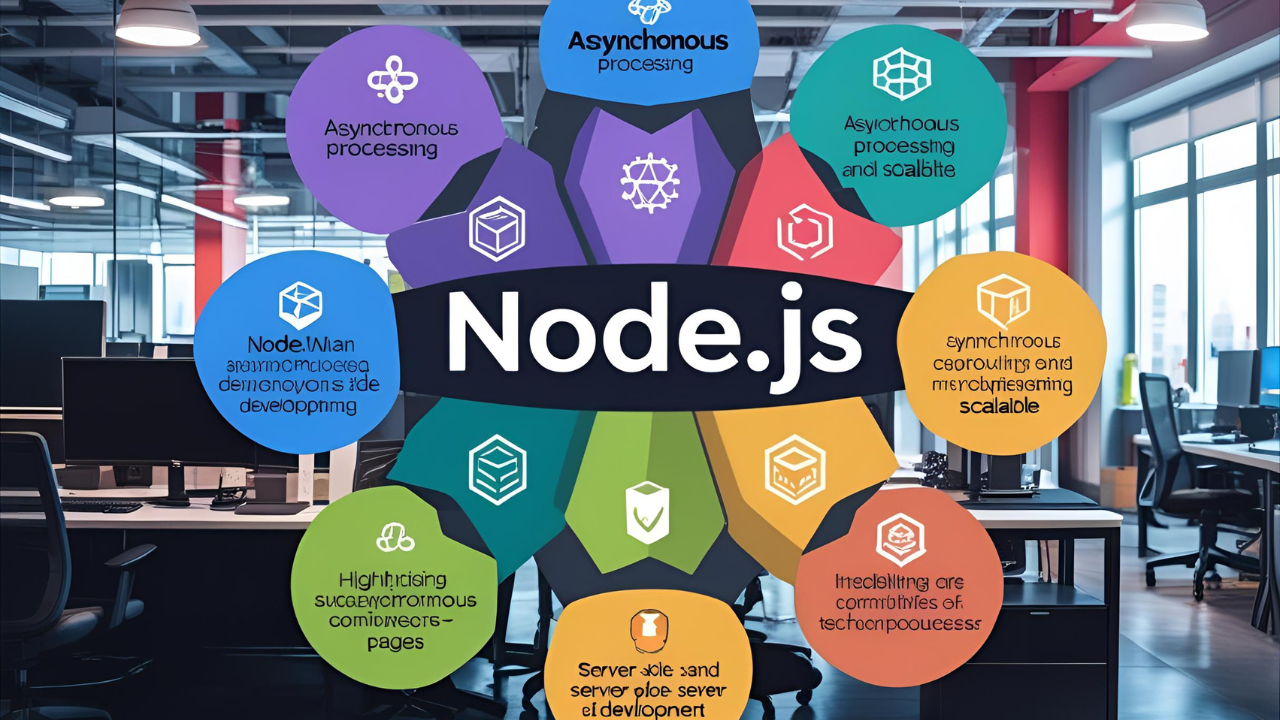🚀 The Benefits of Using Node.js for Server‑Side Development
In the fast‑shifting landscape of web backend technologies, Node.js stands out—not just as a runtime, but as a paradigm. Since its debut in 2009, Node.js has propelled JavaScript from front‑end craft to a robust, scalable server platform. In this post, we peel back the hype, dig into the engineering backbone, examine the business impact, and argue why Node.js remains one of the most compelling choices for modern server‑side development.
1. JavaScript Everywhere: One Language, Full Stack
The “JavaScript everywhere” ethos is more than marketing—it’s a strategic revolution. By enabling both client and server code in the same language, Node.js significantly reduces context switching, code duplication, and onboarding friction:
- Teams share logic, validation, model definitions.
- Prototypes and MVPs spin up rapidly, lowering time-to-market.(Wikipedia)
- Developers fluent in front-end JS can pivot to backend seamlessly—boosting productivity.
- This uniformity fosters tighter collaboration between frontend and backend engineers.
Node.js is thus the backbone of the modern full-stack JavaScript ecosystem: React, Angular, Vue, TypeScript—and server-side modules all tied together.
2. Event-Driven, Non‑Blocking I/O: The Engine Behind Efficiency
At its core, Node.js runs on Google’s high-performance V8 engine, plus its own event loop and non‑blocking I/O layer powered by libuv. This reactor-pattern architecture underpins its scalability:
- A single thread can comfortably handle tens of thousands of concurrent connections—ideal for I/O-bound applications.(Wikipedia)
- Microservices and real‑time systems thrive: chat apps, streaming, dashboards—all benefit from minimal latency and high throughput.
- Node.js powers real‑time giants like Slack, Trello, Netflix authentication layers, and Uber’s live ride updates.(Web Panel Solutions)
- Real-world case: PayPal replatformed from Java to JS/Node.js—achieving faster response (~200 ms) and doubling requests/sec.(DZone)

This architecture demands attention: CPU-heavy logic must be off‑loaded to worker threads or microservices, lest the event loop stalls.(Expert Beacon)
3. Scalability: Horizontal, Vertical, and Microservices Ready
When scaling matters, Node.js delivers:
- Cluster mode leverages all CPU cores, balancing traffic across instances.(Relevant Software)
- Horizontal scaling—spinning new services—is seamless, making it perfect for cloud-native, containerized microservices.
- Industry validation: Walmart saw 20% higher conversion and cut compute by 40% by adopting Node.js + microservices.(DZone)
- Uber, Netflix, PayPal, LinkedIn: all rely on Node.js microservices for performance at scale.(Expert Beacon)
Node.js aligns naturally with modern cloud and serverless patterns, thriving in ecosystems like AWS Lambda, Kubernetes-based deployments, or container orchestration.
4. Large Ecosystem & npm: Accelerate Build, Avoid Reinventing Wheels
npm is the most extensive package registry in the world, enabling:
- Rapid feature integration: authentication, DB connectors, stream processing, real-time messaging, etc.
- Apps built with hundreds or thousands of modules stand up quickly and evolve over time.
- Active governance (OpenJS Foundation) ensures sustainability and trust.(Wikipedia)
Enterprises benefit from mature dependency versioning—semantic versioning, LTS release cycles, consistent patching, and long support corridors.(NearForm)
5. Productivity & Developer Experience
Node.js delivers a developer-friendly environment:
- Front-end devs pick up server-side backend quickly—by virtue of JS, tooling, async/await.
- Debugging, hot-reload, REPLs, Express.js middleware, real‑time logging—tools built for speed.
- Metrics: developers ramp faster and ship code earlier; startups especially profit here.
Case study: NearForm helped a client boost throughput 10x while slashing server cost by 60%.(NearForm)
6. Real‑Time & Streaming Support
Node.js shines when handling real-time communication:
- Native support for WebSockets and streaming APIs around readable/writable streams.(NashTech Blog)
- Slack, Trello, and others rely on Node.js for instantaneous interaction.
- Data streaming scenarios (e.g., Netflix’s playback controls, dashboards, telemetry) are handled gracefully given Node’s efficient stream pipeline.(Reddit)
7. Cost Efficiency
Node.js enables lean deployment:
- Efficient memory and CPU usage reduces infrastructure needs.(AmorServ)
- Smaller teams work faster—development and ops costs shrink.(AmorServ)
- Walmart, Netflix, PayPal all report cost savings by migrating to Node.js.(DZone)
Startups and enterprises alike enjoy lower TCO (total cost of ownership) thanks to Node’s performance-per-dollar ratio.
8. Ecosystem & Corporate Backing
Node.js is backed by the OpenJS Foundation—a merger of Node.js and JS Foundations supported by Google, IBM, Microsoft, PayPal, and more.(Wikipedia)
This ensures:
- Long-term governance and release discipline (e.g. vIron, vJod, vKrypton LTS cycle).(Wikipedia)
- End-to-end support for security, performance tools (e.g. Clinic.JS, diagnostic groups).
9. Cross‑Platform & Cross‑Purpose Capabilities
Node.js scripts run seamlessly across operating systems—Windows, Linux, macOS.
That opens pathways to:
- Build desktop applications (Electron)—VSCode, Slack, Spotify all built atop Node.js.(DZone, Reddit)
- CLI tools, automation scripts, cloud functions—all reusable with JS across environments.
- Unified testing, CI, type-systems (TypeScript) across front, back, and platform tooling.(Wikipedia)
10. Considerations & Limitations 🧠
Even at its peak, Node.js isn’t silver-bullet:
- CPU-bound workloads can block the event loop—best offload heavy computing to workers, microservices, or native addons.(Expert Beacon)
- Large JSON operations at high scale can expose performance issues.
- Security: with wide open npm dependencies, vulnerability scanning and best practices are essential. Some static analysis tools detect only ~57% of OWASP vulnerabilities, and precision remains low.(arxiv.org)
The right architecture and best practices can mitigate most of these trade‑offs (e.g., modular event loops, proper error handling, worker thread off‑loading).
11. Future Outlook: Node.js in 2025 and Beyond
Looking at current architecture and adoption trends:
- Node.js vKrypton (2025‑2028 LTS) is live, with future versions improving native JSON, WASI, WebAssembly support.(Wikipedia)
- Cloud-native, microservices, serverless: Node.js fits natively into Kubernetes, edge computing, and hybrid deployment strategies.
- JavaScript’s popularity continues—TypeScript, Deno—all play into Node.js’s ongoing relevance.
12. Real-World Impact: Enterprise Case Studies
Netflix
- Moved key services to Node.js: load times down 70%.(Expert Beacon)
- Scaled authentication and microservices to support 231M users globally.
PayPal
- Rebuilt checkout stack using Node.js: performance doubled, latency reduced, developer productivity skyrocketed.
Walmart
- Replaced legacy monolith with Node.js microservices; mobile conversion up 98%, cost down 40%.(DZone)
Uber & LinkedIn
- Uber handles 150M users via high-throughput Node services; LinkedIn shifted feed generation using Node.js pipelines.(Expert Beacon)
13. Getting Started: Architecting with Node.js
- Pick a framework: Express, Fastify, NestJS
- Structure microservices: adopt APIs, messaging, event‑driven queues, clusters.
- Use async/await, Promises, streams for non‑blocking I/O.
- Offload heavy computation using worker threads or services.
- Secure your code: linting, validator libraries, npm audit, vulnerability scanning.
- Monitor performance: Clinic.js, diagnostics tools, logging, tracing.
- Leverage Docker/K8s: containerize, scale horizontally, automate CI/CD.
14. Conclusion
If you’re building anything from an MVP to a high‑volume API platform, Node.js remains a go-to choice thanks to:
- JavaScript everywhere, unified teams, shared logic.
- High performance under I/O-bound workloads thanks to event-driven, non-blocking architecture.
- Rich ecosystem of modules and frameworks.
- Cost efficiency, developer productivity, and real-world scalability proven by global brands.
- Strategic relevance in modern architecture: microservices, serverless, edge.
Yes, Node.js has limitations. But thoughtful design, modern tooling, and an informed team can turn those into strengths.
In 2025 and beyond, Node.js continues to lead—not by inertia, but by delivering real technical and business value in an evolving cloud-native digital world.




